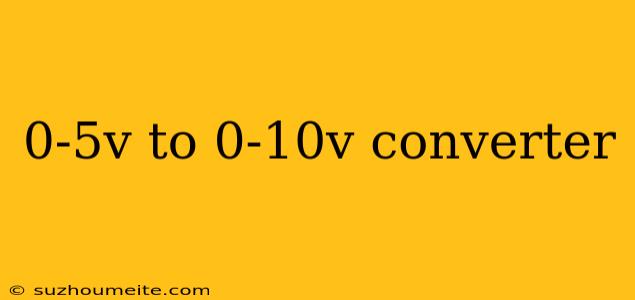0-5V to 0-10V Converter: A Comprehensive Guide
Introduction
In various industrial and electronic applications, it's often necessary to convert a low-voltage signal to a higher voltage signal. One common scenario is converting a 0-5V signal to a 0-10V signal. This is where a 0-5V to 0-10V converter comes into play. In this article, we'll delve into the world of voltage converters, explore the importance of 0-5V to 0-10V conversion, and discuss the different types of converters available.
Why 0-5V to 0-10V Conversion is Necessary
In many industrial control systems, sensors, and transmitters, the output signal is typically in the range of 0-5V. However, some devices, such as programmable logic controllers (PLCs), require input signals in the range of 0-10V. This is where a 0-5V to 0-10V converter is necessary to ensure compatibility and accurate signal transmission.
Types of 0-5V to 0-10V Converters
There are several types of converters available, each with its own strengths and weaknesses:
1. Op-Amp Based Converters
These converters use operational amplifiers (op-amps) to amplify the input signal. They are simple, cost-effective, and widely used. However, they may introduce noise and distortion into the signal.
2. Voltage Multiplier Converters
These converters use a combination of resistors and capacitors to multiply the input voltage. They are more complex than op-amp based converters but offer better noise rejection and higher accuracy.
3. Isolated Converters
These converters use isolation techniques, such as transformers or optocouplers, to isolate the input and output signals. They offer high accuracy, noise rejection, and electrical isolation, making them suitable for applications where high reliability is critical.
4. Digital-to-Analog Converters (DACs)
These converters use digital signals to generate an analog output. They are highly accurate and flexible but may require additional components, such as microcontrollers, to operate.
Design Considerations
When designing a 0-5V to 0-10V converter, several factors must be considered:
1. Accuracy and Linearity
The converter should maintain a high degree of accuracy and linearity across the entire input range.
2. Noise Rejection
The converter should be able to reject noise and interference from the input signal.
3. Power Consumption
The converter should have low power consumption to minimize heat generation and maximize efficiency.
4. Isolation and Protection
The converter should provide isolation between the input and output signals and protect against overvoltage, undervoltage, and electromagnetic interference (EMI).
Applications
0-5V to 0-10V converters have a wide range of applications, including:
1. Industrial Automation
In industrial automation systems, 0-5V to 0-10V converters are used to interface sensors and transmitters with PLCs and other control devices.
2. Process Control
In process control systems, 0-5V to 0-10V converters are used to transmit signals from sensors and transmitters to control systems and recorders.
3. Medical Devices
In medical devices, 0-5V to 0-10V converters are used to interface sensors with medical equipment and instrumentation.
Conclusion
In conclusion, 0-5V to 0-10V converters play a vital role in various industrial and electronic applications. By understanding the different types of converters available and design considerations, engineers can select the most suitable converter for their specific application.
